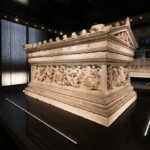Earles Mausoleum
Nadine Earles
April 3, 1929–December 18, 1933
Oakwood Cemetery
Lanett, Alabama
No offense to the 8,500 citizens of Lanett, Alabama, but there isn’t a lot of reason to visit this tidy little town. Well, except for one thing: it has one of the most interesting tombs in America. The tomb of Nadine Earles, though technically called a mausoleum, doesn’t exactly look like a traditional mausoleum. It looks more like a child’s playhouse because that’s exactly what it is. The only deviation from a real playhouse is that little Nadine is buried beneath it, and it is located in Oakwood Cemetery.
Read More»Kampfe Mausoleum
Green-Wood Cemetery
Brooklyn, New York
On June 15, 1880, the Kampfe brothers (Frederick, Richard and Otto F.) patented the Star, the first safety razor manufactured in the United States. Other inventors soon came out with their own safety razors, and from 1880 to 1901 over 80 safety razor patents were issued in the United States. Gillette, often mistakenly credited with the invention of the safety razor, didn’t acquire a patent until 1904. By 1906 a number of the Kampfe brothers’ businesses were consolidated into the American Safety Razor Company. Today the company (now the Personna American Safety Razor Company) produces blades for shaving, medical, and industrial uses.
Read More»Archbold Mausoleum
John Dustin Archbold
July 26, 1848-December 5, 1916
John Dustin Archbold was one of the titans of the Gilded Age. Archbold was born in Ohio, the son of Rev. Israel Archbold and his wife Frances. Israel Archbold died in 1859 and young John became the man of the family. The family moved to Salem, Pennsylvania, which was not far from the soon-to-be-developed oil fields of Pennsylvania. He saved a meager amount of money, and then in 1864 he moved to Titusville, Pennsylvania in the heart of the oilfields. By age nineteen his small investments were paying off; so much so that he was able to buy a home for his mother and send his sister to college.
Read More»Torrio Mausoleum
John “Papa Johnny” Torrio
February 1882 – April 16, 1957
Johnny Torrio had a relatively long life, especially considering his checkered provenance. Johnny Torrio was born in the village of Irsina, Italy then his family immigrated to America when he was two. He grew up in the Lower East Side, becoming involved in the Five Points Gang as a teenager. He quickly developed into a cold, calculating, cunning and crafty criminal. Hence his other Mob nickname “the Fox”. Torrio became, by all accounts wildly successful in his less-than-mainstream profession of running various Mob rackets. He moved to Chicago in 1918 taking his understudy, one Alphonse Capone along with him. Torrio and Capone worked together throughout the 1920’s presiding over the Chicago Outfit. They became multimillionaires running various operations including a bootlegging, gambling and prostitution.
Read More»Rinelli/Guarino Mausoleum
Angels in cemeteries tend to be either heroic or mournful or contemplative. This plus-sized archangel Michael seems to have fluttered on over to the Rinelli Guarino mausoleum and simply alit there, perhaps taking a break before heading to his next destination. Look closely and you’ll see that Michael holds his sword in his right hand at rest across his lap, symbolizing that the earthly struggles of the mausoleum’s inhabitants have ended. His left hand is also in a relaxed pose. The first permanent occupant of the mausoleum was Pietro Rinilli who died in 1913.
Read More»Acea Mausoleum
The perfectly petite Acea mausoleum was constructed by Farrington, Gould and Hoagland, one of New York’s most prolific mausoleum builders. Although the firm was based in New York, they always used granite quarried in Barre, Vermont.
Read More»Romanesque Mausoleums
This row of Romanesque Revival mausoleums, nestled into a hillside, is the eternal home of a number of San Francisco’s founding fathers. Although at first glance the mausoleums all appear the same, there are subtle differences.
Read More»Miller Mausoleum
The George Miller mausoleum is rare both in its architecture and history. It was designed and erected by the Harrison Granite Company in New York City in 1919 in the form of a medieval “keep”. Keeps are the main towers of castles and were usually designed with enough space to serve as living quarters for the royal family in times of siege. One would think that the Miller family must have had some royal lineage in their background, but such is not the case.
Read More»Merritt Mausoleum
The Merritt mausoleum is perched at the very top of Millionaires Row in Mountain View Cemetery. The mausoleum is an unconventional temple form. It would have been considered a daring and high-style expression of personal individuality. There is an interesting play of smooth and rough masonry accented with delicately sculpted Romanesque ornament.
Read More»Potter Mausoleum
The Potter mausoleum, a classic example of Richardsonian Romanesque architecture, has the look of a medieval fortress. It is rare for one individual to be so influential in the popularization of an architectural style that it is named after him, but so it was with Henry Hobson Richardson (1838-1886).
Read More»